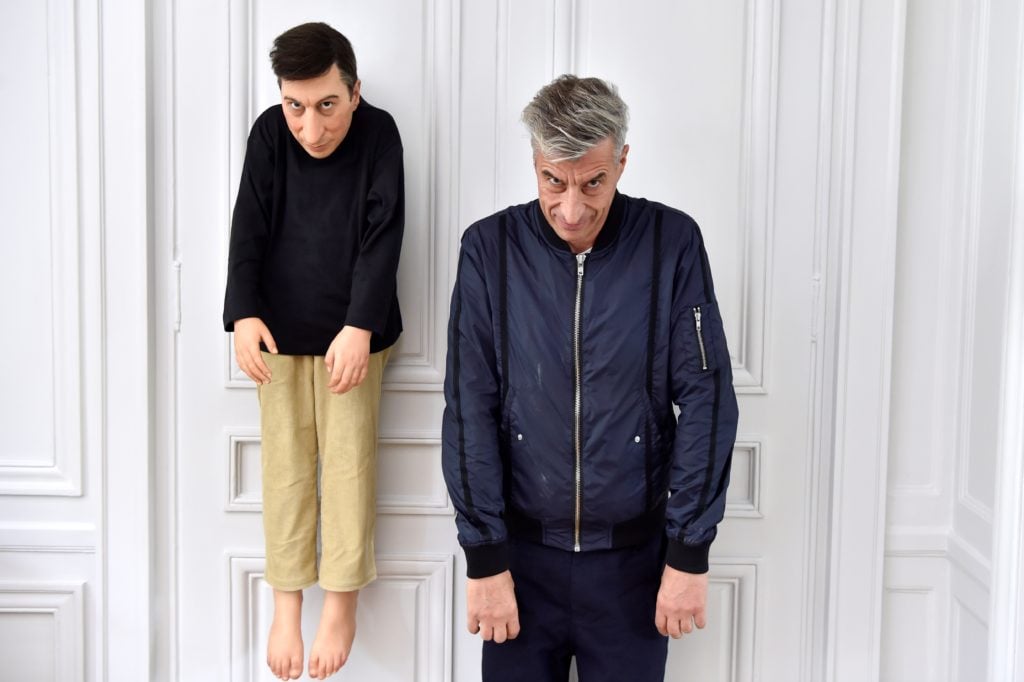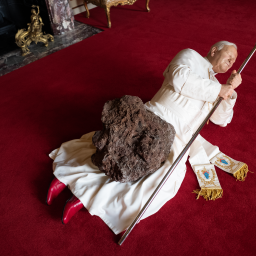In 1999, the artist Maurizio Cattelan achieved a level of virality that was almost unthinkable in the pre-social media era when he exhibited a wax statue of Pope John Paul II struck by a meteorite.
Now, the creator and hand behind that work, as well as some of Cattelan’s other most popular pieces, a sculptor by the name of Daniel Druet, is claiming that he was robbed of his intellectual property by the banana-wielding star of Galerie Perrotin.
In a new lawsuit, Druet alleges that nine of Cattelan’s best-known works are actually based on original wax models made by Druet. Galerie Perrotin says only four were: La Nona Ora, La Rivoluzione Siamo Noi, Him, and Untitled (or Little Cattelan of Rotterdam). Druet is now seeking full authorship and acknowledgement from Cattelan and the gallery, in addition to financial compensation totaling in the millions, according to Le Monde, which broke the news last week.
Druet is aiming to become “exclusive author” of the Cattelan sculptures and is seeking nearly €5 million ($5.25 million) in compensation for breach of his intellectual property, according to the newspaper.
In addition, Druet is seeking damages from the Monnaie de Paris, a museum that staged a major retrospective of Cattelan’s work in 2016, claiming the museum was complicit in the appropriation without attribution of Druet’s original wax sculptures.
The lawsuit ultimately claims that Druet’s rights as an author were infringed because he was never named as creator of the original models and was instead described as a subcontractor.
In a statement sent to Artnet News, Perrotin said that Druet’s claims are unfounded, and that they threaten to disrupt the basic principles of how art is made in the 21st century. The gallery did, however, acknowledge that Druet had created many of the original physical molds and prototypes, but that the ideas and concepts were original to Cattelan.
“The issue of authorship in conceptual art lies at the heart of the dispute between Maurizio Cattelan and Daniel Druet,” Perrotin said in the statement. “There is no doubt that Maurizio Cattelan’s personalitý exists in all of his works through the creative choices he makes, the staging, and the meaning found by each viewer.”
According to Pierre-Olivier Sur, counsel for Galerie Perrotin, “the 100-year-old case law currently governing the criteria to determine an artwork’s authorship is unsuitable for conceptual art.”
While both sides admit that the terms of their collaboration were initially ill-defined (Druet described them as “vague” to Le Monde), the case promises to be a landmark when it comes to establishing how far artists can outsource their work before others involved in the artistic process can challenge its IP.
“We were naive,” Emmanuel Perrotin told the French newspaper, noting that Druet and Cattelan “did not talk about a contract.” He added that Cattelan paid the sculptor for his work and that he was not in any kind of financial arrears with Druet.
The case begins on May 13 in a chamber of the Paris court dedicated to intellectual property.







